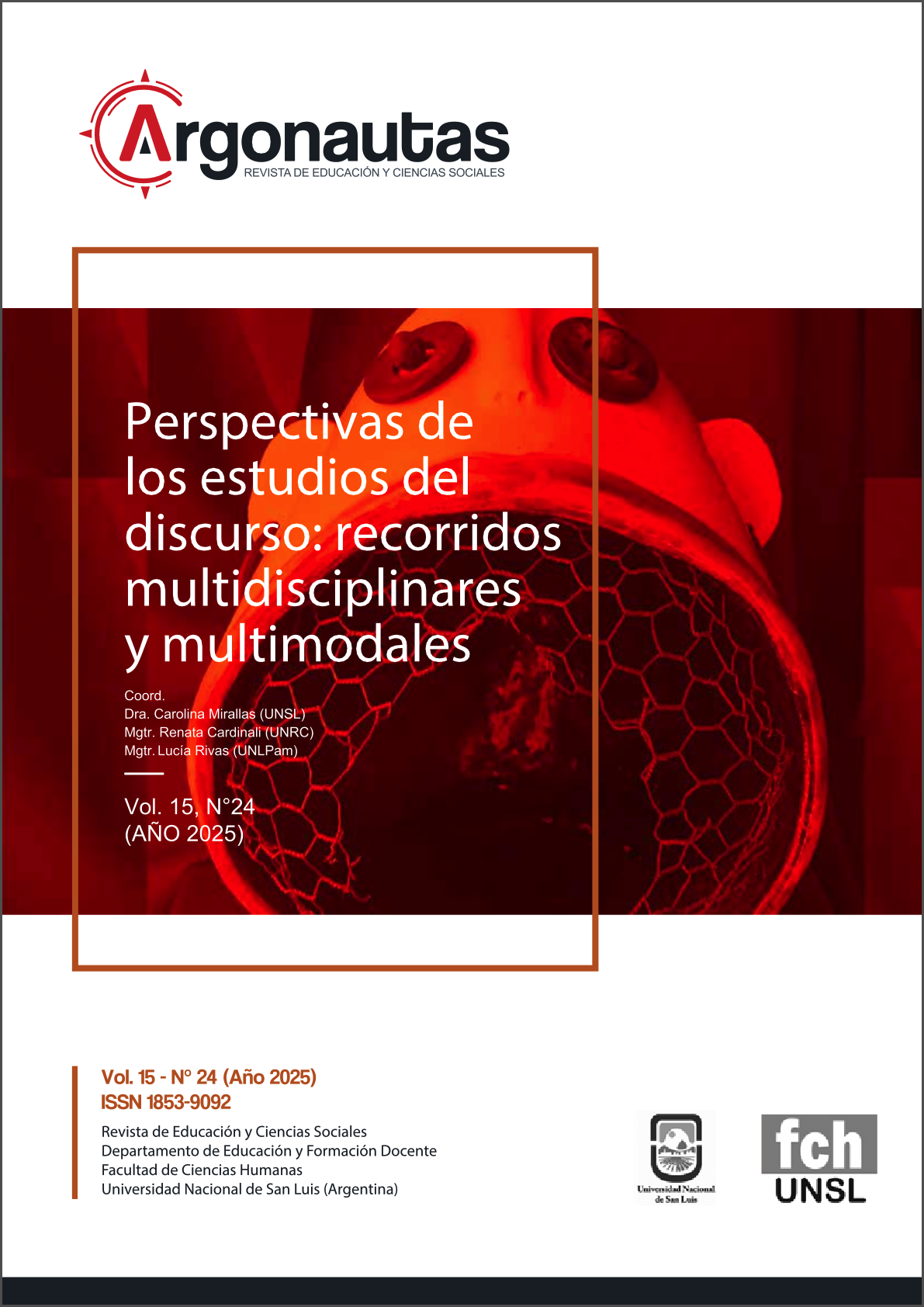(Being) 'Susanita' as a discursive construction: a semantic, pragmatic and cognitive study of its use in Argentine media
Keywords:
Quino's character, diminutive, proper noun, lexicalization, pragmaticalizationAbstract
Discourses construct and sustain mental models that impose interpretive frameworks on social issues. Through language use, discursive subjects not only account for their processes of subjectivization, but also configure themselves in a specific context and permanently construct and redefine their social and cultural constructs. This paper proposes a semantic, pragmatic and cognitive description of the media occurrences of the segment “(being) Susanita” according to speakers’ use in Argentina. We resort to the postulates of the Cognitive Grammar (cognitive-prototypical approach) (Langacker, 1987), Frame Semantics (Fillmore, 1982), Idealized Cognitive Models (ICM) (Lakoff, 1987), and Grammaticalization and Lexicalization (Hopper and Traugott, 1993), as well as those related to discursive construction (Croft & Cruise, 2004; Goldberg, 1995). We collected 27 instances of the segment under study from Argentine media and analyzed them based on the ICMs of the character Susanita from Quino's comic strip. We found that while the character concentrates a multiplicity of traits that are constructed from her participation in the narrative of the strip and that are stereotypical of diverse social groups, speakers’ use of “(being) Susanita” in the media highlights the value of motherhood and the need for women to have many children. In conclusion, we observe that media use of “(being) Susanita” contributes to reinforcing and redefining social representations linked to gender stereotypes and ideal models of behavior.
Downloads
References
Alonso, A. (1935). Noción, emoción, acción y fantasía en los diminutivos. Madrid: Gredos.
Company Company, C. (2016). “Gramaticalización y cambio sintáctico”. En J. Gutiérrez-Rexach, Enciclopedia de Lingüística Hispánica (págs. 515-526). London: Routledge.
Croft, W. & Cruse, D. D. (2004). Cognitive Linguistics. Cambridge: Cambridge University Press.
Cuenca, M. & Hilferty, J. (1999). Introducción a la lingüística cognitiva. Barcelona: Ariel.
Cucatto, M. (1998). “De la Lingüística Cognitiva al Análisis del Discurso”. RASAL. Revista de la Sociedad Argentina de Lingüística, 1, 53-65. Dostie, G. (2004). 2004. Bruxelles: De Boeck/Duculot.
Fillmore, C. (1982). “Frame Semantics”. En L. S. Korea (Ed.), Linguistics in the Morning Calm (2006 ed., págs. 111-138). Seoul: Seoul Hanshin Pub. Co.
Fontanier, P. (1977). Les figures du discours. Paris: Flammarion.
Goldberg, A. (1995). Constructions: A Construction Grammar approach to argument structure. Chicago: University of Chicago Press.
Hernández, P. (2014). “"Je sens que ça va partir en Houellebecq ce truc”: sur le sens des noms d’écrivain en syntagme prépositionnel”. HAL Open Science, 483-498.
Hopper, P. (1987). “Emergent grammar”. Proceedings of the Thirteenth Annual Meeting of the Berkeley Linguistics Society (193-157). Berkeley, California: Linguistic Society of America.
Hopper, P. & Traugott, E. C. (2003 [1993]). Grammaticalization (2da ed.). Cambridge: Cambridge University Press.
Hummel, M. (1997). “Para la lingüística de vuestro diminutivo: los diminutivos como apreciativos”. Anuario de Estudios Filológicos(20), 191-210.
Kornfeld, L. (2016). Una propuestita astutita: el diminutivo como recurso atenuador». Revista Internacional de Lingüística Iberoamericana (RILI), 14(27), 123-136.
Kripke, S. (1981). Naming and necessity. Blackwell: Oxford.
Lakoff, G. (1987). Women, Fire, and Dangerous Things: What Categories Reveal about the Mind. Chicago: Chicago University Press.
Langacker, R. (1987). Foundation of Cognitive Grammar (Vol. 1). Theoretical Prerequisites. Stanford: Stanford University Press.
Martín Zorraquino, M. A. (2012). “Sobre los diminutivos en español y su función en una teoría de la cortesía verbal (con referencia especial a un cuento de Antonio de Trueba)”. En T. Jiménez Juliá, B. López Meirama, V. Vázquez Rozas & A. Veiga Rodríguez, Cum corde et in nova grammatica (estudios ofrecidos a Guillermo Rojo) (555-569). Santiago de Compostela: USC.
Meillet, A. (1912). “L'évolution des formes gramaticales”. En Linguistique Historique et Linguistique générale. Paris: Champion.
Montes Giraldo, J. J. (1972). “Funciones del diminutivo en español: ensayo de clasificación”. Thesaurus, 27(1), 71-88.
RAE (2012). Manual de la Nueva Gramática de la Lengua Española. Editorial Espasa.
Reynoso Noverón, J. (2005). “Procesos de gramaticalización por subjetivización: el uso del diminutivo en español”. En D. Eddington (Ed.), Selected Proceedings of the 7th Hispanic Linguistics Symposium (págs. 79-86). Somerville, MA, USA: Cascadilla Proceedings Project.
Rosch, E. (1973a). “Natural categories”. Cognitive Psychology, 4(3), 328-350. Recuperado de: https://doi.org/10.1016/0010-0285(73)90017-0
Rosch, E. (1973b). “On the Internal Structure of Perceptual and Semantic Categories”. En T. Moore, Cognitive Development and Acquisition of Language (111-144). New York: Academic.
Rosch, E. (1975). “Cognitive representations of semantic categories”. Journal of Experimental Psychology: General, 104(3), 192-233. Recuperado de: https://doi.org/10.1037/0096-3445.104.3.192
Satne, G. (2005). “Por qué los nombres propios no tienen sentido”. Virtualia. Revista digital de la Escuela de la Orientación Lacaniana, 2-5.
Traugott, E. (1989). “On the Rise of Epistemic Meanings in English: An Example of Subjectification in Semantic Change”. Language, 65(1), 31-55. Recuperado de: https://doi.org/10.2307/414841
Traugott, E. (1995). “Subjectification in grammaticalization”. En D. Stein (Ed.), Subjectivity and Subjectivisation. Linguistic perspectives (31-54). Cambridge, UK: Cambridge University Press.
Zuloaga Espina, A. (1970). La función del diminutivo en español. Thesaurus, XXV.







